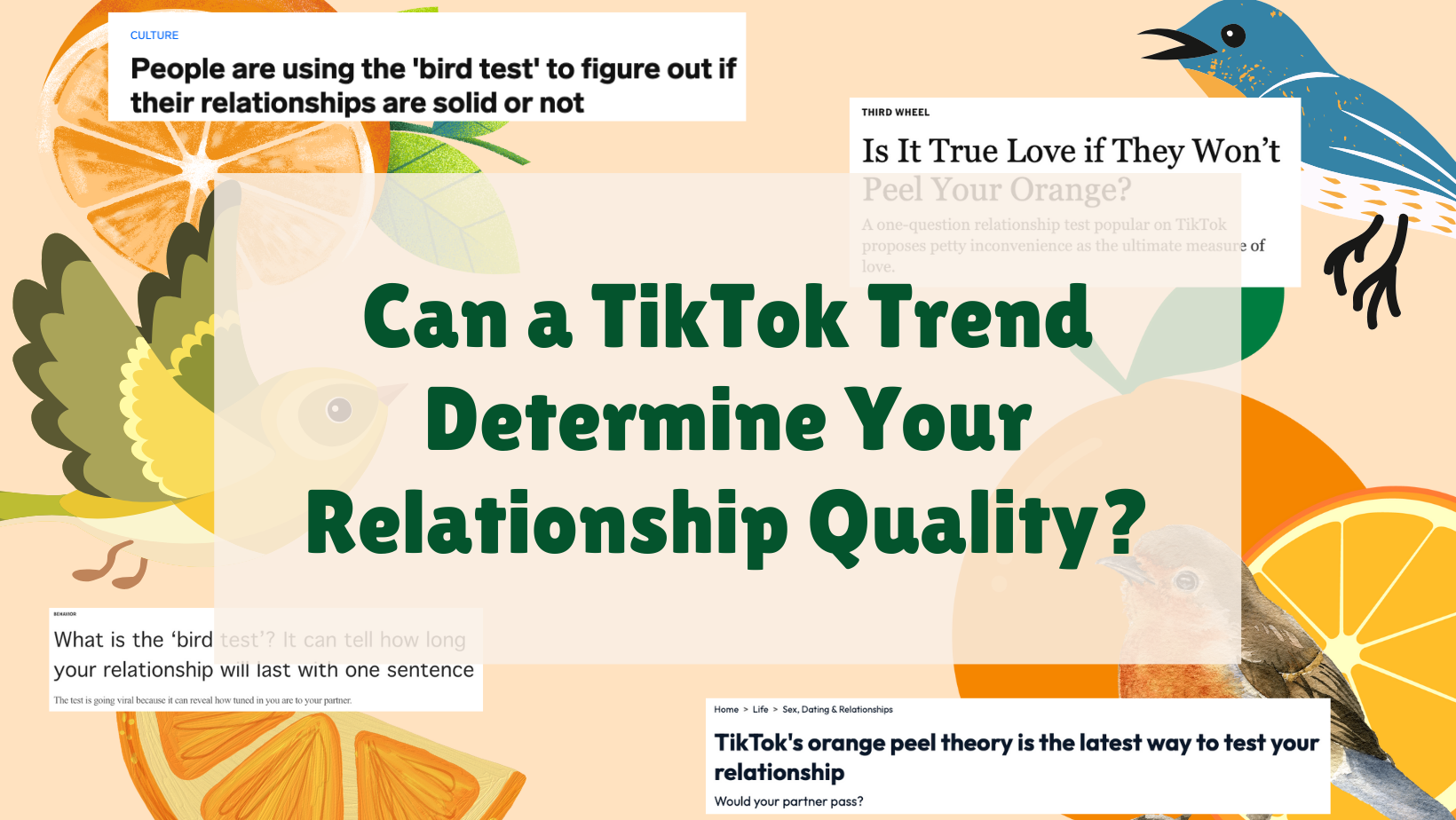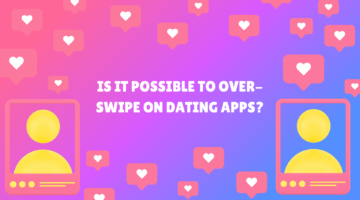Can a TikTok Trend Determine Your Relationship Quality?
February 14, 2024 by Emily Mendelson
Did preparing for Valentine’s Day feel a little extra stressful this year? If so, you might have social media (and, in particular, TikTok) to blame. For example, among the many trends we’ve recently seen are girlfriends putting their boyfriends up for “sale” if they haven’t been asked to be their Valentine. Even if the videos are lighthearted, it’s easy to see how having a partner complain about you (or shame you) on social media could lead to some relationship strain.
TikTok is notorious for popularizing relationship trends that individuals can use to “test” their own partners or relationships and see if they pass. However, is there any scientific validity to these tests? Can they really tell you anything about the quality of your relationship? We’re going to dive into why TikTok has the power to affect our relationships, then look at two trends (specifically, the “bird test” and “orange peel theory”) to see if there is any research that might support their underlying premises.
TikTok’s Influence on our Relationships
As of January 2024, TikTok has over 1 billion active users who spend an average of 95 minutes (over an hour and a half!) on the application per day. The app is most popular among 10-19 year olds (32.5%), followed by 20-29 year olds (29.5%). In fact, an internal figure from Google revealed that approximately 40% of young people prefer to search for specific information on TikTok and Instagram, such as where to go for lunch, instead of on Google or Maps.
With these numbers, it’s easy to see how TikTok content can reach a wide range of young, impressionable users who might be (a) specifically looking for information about romantic relationships or (b) learning about relationships as they see viral relationship memes and trends. For example, you may have heard of the “couch guy” sensation a few years ago that depicted a boyfriend’s underwhelming response to his long-distance girlfriend surprising him at college. When I studied this trend, I found that individuals on TikTok used “couch guy” as an opportunity to engage in processes of active learning about relationships. This was done by users commenting on the video, sharing their opinion about the video (and whether his reaction indicated cheating), and posting their own content about romantic surprises to make a joke or demonstrate what his reaction “should” have looked like.
As this process occurs, individuals are not just learning about other people’s relationships. Users on TikTok are also collectively deciding on relationship norms, particularly how male partners should act in a relationship. [1] Because there are so many users on TikTok, this process is constantly reinventing itself as relationship trends evolve and continue to rise in popularity.
Now let’s take a look at some specific TikTok trends: the “bird test” and “orange peel theory.”
The Bird Test
The Bird Test is fairly simple. The basic premise is that if you look out the window and exclaim something to the effect of “wow, look at this amazing bird!”, your partner’s response can indicate something about the strength of your relationship. It’s possible your partner may react enthusiastically and go look at the bird with you. Or they might ignore your exclamation and just keep looking at their phone. Or maybe they’ll say something dismissive. Given these possibilities, partners “pass” the bird test if they engage in looking at the bird with you. To be clear, the “bird” can really be anything (e.g., “check out this dog!” or “guess what I got at the grocery store!”), but birds are the most widely used example.
Although asking your partner to go look at a bird may seem like an innocuous act, there might be some truth to the bird test. In fact, the bird test is reflective of a famous experiment conducted by John Gottman of the Gottman Institute, where he observed how couples responded to each other when they would make exclamations similar to those described above. He coined these interactions as “bids for attention,” which he studied as a way to predict whether romantic partners will stay together.
Bids for Attention
Gottman describes bids for attention as “the fundamental unit of emotional communication” [2,3]. Bids can be both verbal (“look, a bird!”), and nonverbal, including acts of affectionate touch, facial expressions (e.g., winking or smiling at a partner), or gestures that motion towards a particular place or activity. When individuals make bids for attention, they are looking to connect with others. Partners can respond to bids by turning towards them (“wow, what a cool bird!”), turning away from them (giving no response to the bird), or even turning against them (“who cares? Birds are stupid”).
When partners turn towards bids, the person making the bid feels affirmed in making an emotional connection. Someone who frequently turns against their partner’s bids for attention is likely to cause feelings of resentment and loneliness instead. If you’re looking to enhance your emotional connection with your partner (or even your friends!), it’s recommended to turn towards bids instead of turning away from them. Go look at that bird!
The Orange Peel Theory
The Orange Peel Theory is intended to determine the extent to which a romantic partner will perform small acts of service for you despite the fact that you are capable of doing them yourself. The test is simple, someone asks their partner to peel an orange for them, and their partner “passes” the test if they say yes and peel the orange. The more enthusiastic someone is about peeling an orange for their partner, or, the attention to detail that is paid when doing so, is understood to be an additional indicator of someone’s feelings towards their relationship.
Compared to the bird test, the orange peel theory is slightly more complicated. First, some individuals who are “tested” are confused when their partners are suddenly interested in eating oranges if that’s not something they regularly do. Of course, the act of peeling an orange can be replaced with any other small task, but being explicit about oranges is a way for someone to ensure their video fits within the larger trend. Second, there is not as clear of a connection between the orange peel theory and relationship science, but here are some thoughts.
Acts of Service and Partner Responsiveness
Last year for Valentine’s Day, we explored how adhering to your partner’s love languages might enhance your relationship. Although the love languages are flawed scientifically (which you can learn all about in our recent podcast episode with Drs. Amy Muise and Emily Impett), individuals do appear to be more satisfied with their partners when they feel that their love languages are being “spoken” [4]. In this case, orange peel theory may reflect the desire for being loved through acts of service, no matter how small.
Another relationship science concept that might connect to the orange peel theory is the idea of perceived partner responsiveness [5]. We see our partners as being responsive when they validate us, support our needs, and we feel understood by them. Research has found that perceived partner responsiveness is higher when partners engage in active listening [6] and, further, that greater perceived partner responsiveness is linked to increased relationship satisfaction. Peeling an orange, then, is a simple way to validate and support a romantic partner’s needs, even if they are able to peel it themselves.
Should You Judge Your Relationship Based on TikTok?
Short answer? No. Although there may be some connection between the relationship trends we see online and relationship science, putting your partner through a series of “tests” just for the sake of it might make you feel more insecure in the end, particularly if your partner “fails” the test in your eyes. Also, depending on how you carry out the test, you might be setting your partner up to fail (for example, if your partner is working from home and you interrupt them to ask them for something unusual that you don’t really need and could easily do yourself, like peeling an orange, this isn’t a very good way to gauge your relationship health).
The bigger question to ask yourself is why you feel a need to test your partner anyway. Oftentimes, this is a sign of some attachment anxiety or insecurity. A constant need to “test” your relationship might say more about you than your partner. But it can also be a sign that there are some deeper problems or issues in the relationship that need to be addressed. Following a TikTok trend isn’t going to help very much in either of these cases. Instead, the answer might reside in improving your relationship communication, or perhaps consulting with a relationship or couple’s therapist.
Yes, TikTok can potentially be helpful for illuminating when individuals are being treated poorly in their relationships and, sure, it can be fun to participate in online trends. However, it’s generally not a good idea to judge your own relationship based on what you see on social media. Instead, you and your partner might want to turn your phones on “do not disturb” this Valentine’s Day to really pay attention to one another and do something good for your relationship.
Want to learn more about Sex and Psychology? Click here for more from the blog or here to listen to the podcast. Follow Sex and Psychology on Facebook, Twitter (@JustinLehmiller), or Reddit to receive updates. You can also follow Dr. Lehmiller on YouTube and Instagram.
References:
[1] Mendelson, E. A. (2023). Sensemaking and public intimacy on TikTok: How viral videos influence interpersonal relationships offline. New Media & Society, 14614448231163231. https://doi.org/10.1177/14614448231163231
[2] Gottman, J., & DeClaire, J. (2002). The relationship cure: A 5 step guide to strengthening your marriage, family, and friendships. Harmony/Rodale.
[3] Gottman, J., & Gottman, J. (2017). The natural principles of love. Journal of Family Theory & Review, 9(1), 7–26. https://doi.org/10.1111/jftr.12182
[4] Hughes, J. L., & Camden, A. A. (2020). Using Chapman’s five love languages theory to predict love and relationship satisfaction. Psi Chi Journal of Psychological Research, 25, 234–244. https://doi.org/10.24839/2325-7342.JN25.3.234
[5] Reis, H. T., & Shaver, P. (1988). Intimacy as an interpersonal process. In Handbook of personal relationships: Theory, research and interventions (pp. 367–389). John Wiley & Sons.[6] Itzchakov, G., Reis, H. T., & Weinstein, N. (2022). How to foster perceived partner responsiveness: High-quality listening is key. Social and Personality Psychology Compass, 16(1), e12648. https://doi.org/10.1111/spc3.12648

Dr. Justin Lehmiller
Founder & Owner of Sex and PsychologyDr. Justin Lehmiller is a social psychologist and Research Fellow at The Kinsey Institute. He runs the Sex and Psychology blog and podcast and is author of the popular book Tell Me What You Want. Dr. Lehmiller is an award-winning educator, and a prolific researcher who has published more than 50 academic works.
Read full bio >


